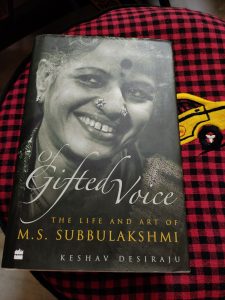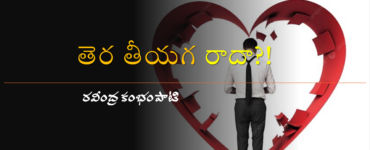When the cassette recorder became part of our lives, mornings at home would often begin with the “Venkateswara Suprabhatam” sung by the inimitable M.S. Subbulakshmi. That was my introduction to the singer. There were many other cassettes of her too, ones that Amma had got on her trips to South India, along with cassettes of other musicians and Telugu film songs as well. There were times when she looked for these cassettes in a couple of shops in Calcutta, only to be disappointed. The book that I write of in this month’s column is Of Gifted Voice: The Life and Art of MS Subbulakshmi by Keshav Desiraju.
Deshiraju wonderfully chronicles the life of M.S. Subbulakshmi steering clear of taking sides in any of the debates and controversies that surround the singer’s life and art. The book is a well-researched work that carries the reader into and across the world of Carnatic music, laying out details of the socio-cultural scenario of the world that M.S. Subbulakshmi inhabited.
Subbulakshmi was born at a time of extraordinary developments in the life of the nation, a time when the nationalist cause was gaining strength and when fundamental changes were taking place in society. Women were particularly impacted and it is worthwhile to look at the changes which were taking place.
M.S. Subbulakshmi’s life (1916-2004), times and career take us across the story of this wonderfully talented woman who belonged to a devadasi family in Madurai, of her mother who had ambitious plans, of her move to Madras (Chennai), her affair with a married man, of her taking on the role of an upper class woman, of a controlling marriage, of the many public platforms that gave her fame and recognition, in India and abroad, and of her status as a celebrity.
The book not only reveals about the life of MS but also speaks of her life in the context of other gifted women artists of the time who held their own n the world of music, dance and films – DK Pattammal, NC Vasanthakokilam, Rajam Pushpavanam, Balasaraswathi, KB Sundarambal, ML Vasanthakumari, among others. The stories of these women, whose lives crossed and influenced that of M.S. Subbulakshmi, take us into the way class, caste and gender worked. One of the most interesting story that parallels that of M.S. Subbulakhsmi is that of the dancer Balasaraswathi – with M.S. Subbulakshmi moving away from her devadasi roots and Balasaraswathi holding on to them.
Amid this galaxy of talented women, the story of M.S. Subbulakshmi’s meteoric rise and success stands out. Throughout the book Desiraju tries to locate reasons for this success story. M.S. Subbulakshmi music appealed to a large cross section of people, and it was because of this that she held her sway for years. A part of this success story, Desiraju suggests, owes itself to the role played by her husband – in the way he handled her career turning her into a national and global figure, building up an image of the singer that has stayed on. None of this, Desiraju argues takes away anything from the musical genius of M.S. Subbulakshmi.
Subbulakshmi’s long and distinguished, even unparalleled, career as a performer who supported worthy causes began in the 1940s. Sadasivam’s involvement in the national cause had brought him close to Rajaji; his canny perception of the public arena led to two developments, both enormously significant in shaping Subbulakshmi’s public image as a national figure.
It is her genius that pervades this book – her music, the dedication to her art, her spirituality, the various kacheris and sabhas she performed at in the South of India and elsewhere. This despite the fact that over the years her repertoire had become somewhat restricted – “With all the limitations she imposed on herself, Subbulakshmi was without doubt amongst the greatest performing artists of her century,” “always on test and always in control”. She was the face of Carnatic music for almost half a century. Desiraju places M.S. Subbulakshmi along with five women singers from across the world, each of whom worked hard and had to face insurmountable odds to reach the pinnacle and influence generations – Edith Piaf, Ella Fitzgerald, Umm Kulthum, Joan Sutherland and Maria Callas.
Keshav Desiraju’s biography of M.S. Subbulakshmi brings a warmth and keen sense of perception as he understands and presents the music, the history of music, its performance, the artist and her genius. Of Gifted Voice narrates the way music began to be performed in concerts, the influence and impact of the gramophone, the radio and the talkie films on music and music performances. The slow decline of traditional families who gave up performances and the emergence of women performers in country that was slowly coming into its own and changing with the ties. The book also speaks about Subbulakshmi’s acting career.
*









Add comment